|

Bobby's Creole
Bob Suberi grew up on the West Coast in
Lakewood, California. He graduated from Mayfair High School in 1966.
Barbara Walters grew up on the East Coast in
Westbury, New York. She graduated from W. Tresper Clarke High School
in 1969.
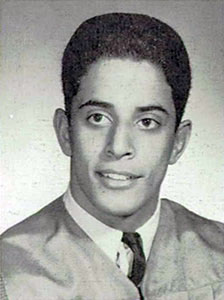 |
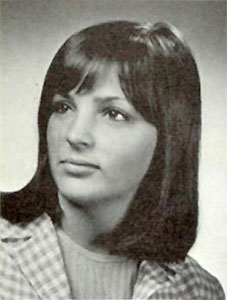 |
Bob
Suberi
Mayfair High School, 1966 |
Barbara
Walters
W. Tresper Clarke High School, 1969 |
Bob Suberi and Barbara Walters met in 1975 at
the University of Michigan, where they were doctoral candidates in
pharmacology. But by the following year, they realized that
pharmacology wasn't something either one of them wanted to do.
Bob’s roommate's wife
was a professor at Wash U in Chinese studies and she told us
about this guy who was running seafood from New Orleans up to
St. Louis and he wanted to go back to school. He wanted to get
rid of it, and we thought, that sounds pretty Bohemian, let’s go
check that out. And that’s how we ended up here running seafood.
Suberi and Walters built a small fish stand for University City's Market in the Loop,
in the 6600 block of Delmar. They drove back and forth to New
Orleans once a week to procure shrimp, fish, oysters, crabs and
spices, and sold them from their stand on Saturdays.
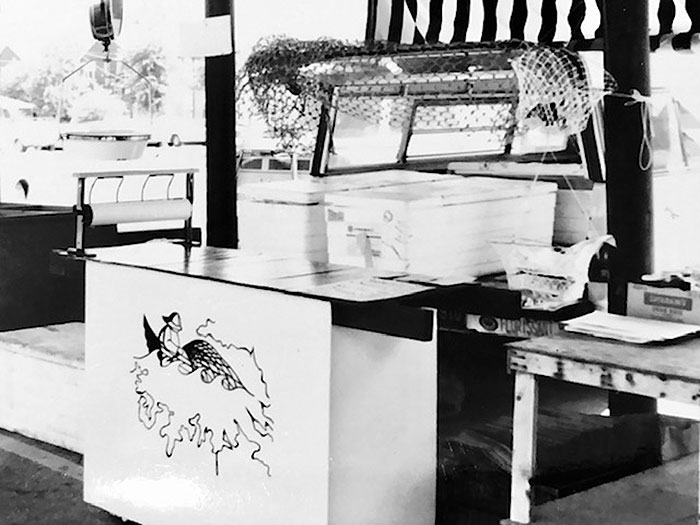 |
| Suberi
and Walters' seafood stand in the U City Loop |
The fish stand was
kind of a means to an end. Bob had this idea of a restaurant.
His mother was an incredible cook and she ran the kitchen at the
University of Judaism in Hollywood. He kind of had it more in
his blood than I did. I was the queen of the peanut butter and
jelly sandwich. But I also had a really strong science
background. I knew how to run experiments. There’s a correlation
there. I had that type of mind that ultimately could look at a
cookbook and tell you what it’s going to taste like. This will
work with this and that will work with that.
Suberi and Walters lived in an apartment in the
Loop and frequented a small vegetarian restaurant on Delmar.
We had eaten at Our
Daily Bread, it was really cheap, you go in there and you get
coffee for a quarter and sit there all day long. So we would
have our little meetings and stuff there. The guy wanted to sell
it; he went on to become an architect. And so we just bought the
business from him, not the building. It was kind of perfect; it
was a good size.
Bobby's Creole opened in July of 1977 at
6318 Delmar, just east of the Tivoli Theatre and west of Streetside
Records.
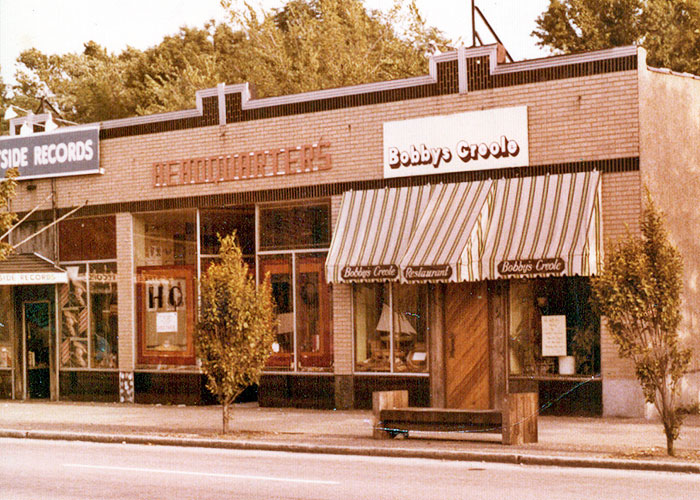 |
| Bobby's
Creole, 6318 Delmar |
Both Suberi and Walters had grown up with the
nickname "Bobby," although Walters had reverted to Barbara in
college.
I wanted to call it
Walters’ and he wanted to call it Suberi’s, and I’m like, well
that’s not going to work. So we had a friend that came in and
said, “Why don’t you just call it Bobby’s?” And we were like,
“Whoa, well that’s a good idea! What a nice compromise."
Bobby's Creole seated 35 and looked much
the way it did when it was Our Daily Bread, with a simple decor and
a variety of mismatched chairs. Initially, the two owners cooked
together in the kitchen, but once they obtained a liquor license the
following spring, Suberi became bartender and host.
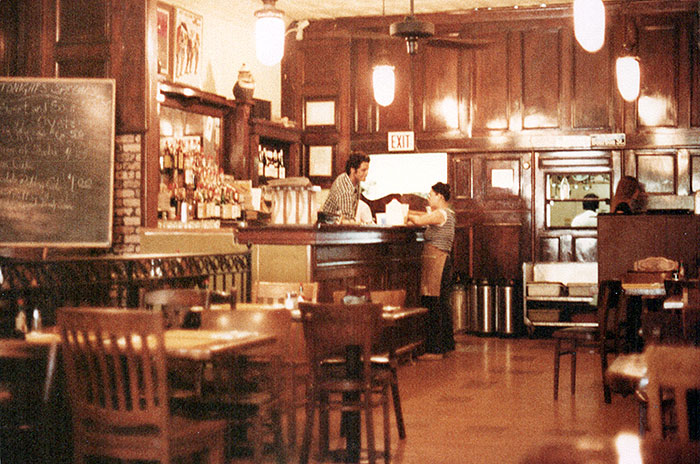 |
| Bobby's
Creole Interior, 6318 Delmar |
About a month after opening Bobby's Creole, Bob
Suberi and Barbara Walters decided to get married. This posed a
problem for St. Louis Post-Dispatch restaurant critic Joe
Pollack, as detailed in his September 14, 1977 review of the
restaurant.
Following normal
procedure, I waited about a month from its opening, then dropped
by for dinner one evening. It was a pleasant visit, and I made
plans to return.
That's when the difficulties began.
My next trip was brought up short by a sign in the window that
said, "Closed for Honeymoon," but that's understandable, and I
muttered some sort of congratulatory words around some profanity
as we searched for another establishment. When I went by again,
the sign had been changed to read, "Closed on Tuesdays," and
it's easy to figure what day it was.
Pollack's third trip to the restaurant was a
success, and after his glowing review, business took off.
Bobby's Creole offered authentic Creole
cooking. The restaurant's menu was heavy with shrimp and oysters. Barbara Suberi
had found many of the recipes on her weekly
fish runs through the Louisiana bayous. The rest were compliments of
the New Orleans Times-Picayune.
The
restaurant critic for The
Times-Picayune put out a great cookbook and I would take
that cookbook and just pick it apart. And that’s where a few of
the more sophisticated recipes came from. Between the ladies in
the bayous and The Times-Picayune, that’s pretty much
where all the recipes came from.
But then I’d have to be constantly
adjusting for St. Louis palates. There would be people who would
come up from New Orleans and say, "That’s not very spicy." Well,
have you eaten in other restaurants in St. Louis?
We’re a lot more sophisticated in our
restaurants now and in our palate. Bun back then we had Chinese
food, Italian food and then we came along.
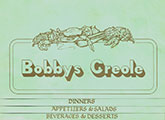 |
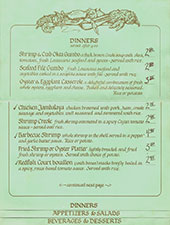 |
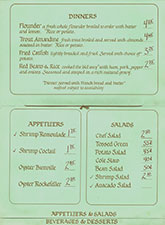 |
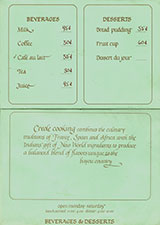 |
Bobby's Creole Menu, 1977
(click image to enlarge) |
In June of 1978, the Suberis sold their Market
in the Loop seafood business, which they had continued to operate
along with their restaurant. They sold it to another Bob and Barbara
– Bob and Barbara Mepham – who would sell fish for many years
thereafter as Bob's Seafood.
By the summer of 1979, Bobby's Creole had
outgrown their space. Plus, the Suberis wanted to add a separate bar
area with live music to their restaurant. So they purchased the
building across the street at 6307-09 Delmar. The 6307 address had
been occupied by the Mound City Shelled Nut Company since 1964 and
was about three times the size of their restaurant.
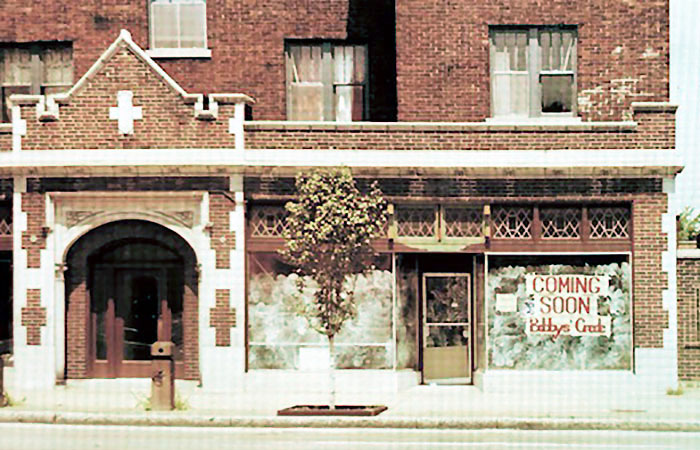 |
|
6307
Delmar, Summer 1979 |
By September of 1979, Bobby's Creole had moved
across the street. Originally, the bar and restaurant were both in
the front. Once the back was rehabbed, the front became a lounge
with a bar and live music.
The back dining room had a New Orleans street scene on one wall, with
colorful canopies above the tables and window shutters on an adjoining wall.
Carnations in praline liqueur bottles decorated the tables.
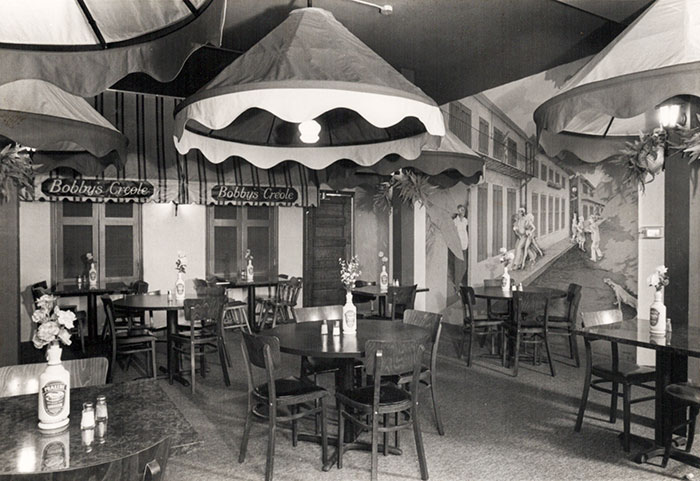 |
Bobby's
Creole Dining Room, 6307 Delmar
(click image to enlarge) |
 |
| Bobby's
Creole Dining Room, 6307 Delmar |
While its address had changed, Bobby's Creole continued to offer a mixture of Cajun and Creole dishes.
Several times a week, freshly caught crab, shrimp and fish were
driven in from New Orleans. In an October 11, 1979 review, Joe Pollack was
still enthusiastic about the
Suberis' menu.
As far as the food
was concerned, we found it splendid. Items that should have been
freshly prepared turned out to be exactly that, and everything
was hot and flavorful. Someone in the kitchen knows just how
long to cook fish so that it is tender, yet perfectly flavorful.
At the same time, dishes that require
lots of cooking received it, so that the herbs and spices could
permeate everything and the various flavors blend properly. Red
beans and rice, with chunks of spicy sausage, were a perfect
example of that, and even though I'm not a great fan of the
dish, I could enjoy it.
The same was true of both gumbos,
which we also sampled as appetizers. I like the file better, but
both were quite good, with plenty of bay leaf.
Oysters Bienville were fresh and
juicy, with a pleasant cheese sauce, and the
shrimp with remoulade sauce was outstanding. The shrimp were
exceptional, large and pink and unpeeled, cooked so that they
retained all their flavor and texture in sharp contrast to too
many restaurants where the shrimp is cooked into mushy oblivion.
The remoulade sauce, served on the side, had a wonderful bite of
spice, and even though peeling shrimp is not the neatest
activity for an evening, the effect was spectacular.
It's been a long
time, but the crab cakes at Bobby's, light and hot, with a
slight taste of pepper and the sweetness of crab meat, were the
best I've had since my last visit to Chesapeake Bay or the press
box at Memorial Stadium, where the World Series writers have
been enjoying them the last couple of nights.
Since catfish was on the menu one
night, it had to be ordered, and it was very good, with a light
batter and a perfect finish on the fish itself. Speaking of
fish, I also tried the red fish fillets, simmered in hot sauce
and found them a real winner. The sauce had a splendid tang,
with lots of green pepper, celery and tomato to mix with the
fish stock for outstanding flavor.
On the simpler side, fried oysters
were freshly cooked so that the juicy bivalves, helped by a
light batter, were a delightful experience.
The dessert list varies from day to
day, but we were able to sample such delights as chocolate
pudding cake, apple crisp and rum cake, while passing the
bread pudding, which apparently is a standby.
 |
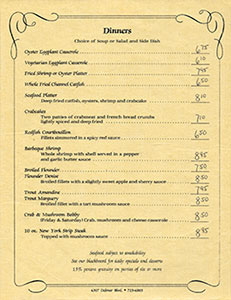 |
Bobby's Creole Menu, 1980
(click image to enlarge) |
Bobby's Creole continued to thrive. In the
April 1985 issue of St. Louis Magazine, Whit Crowson wrote,
"I visited there recently to help assuage my Creole cravings, and
brought a friend who was born and raised in New Orleans, to lend an
extra bit of experience to my critical eye – as a matter of fact,
she came away feeling a little homesick, much to Bobby’s credit and
her husband’s chagrin."
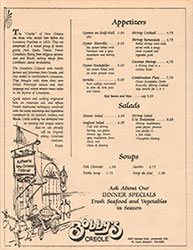 |
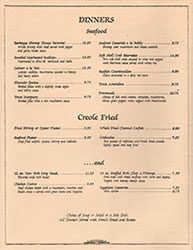 |
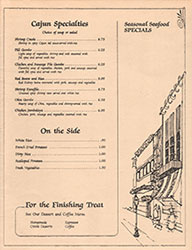 |
Bobby's Creole Menu, 1985
(click image to enlarge) |
However, by the spring of 1985, Bobby's Creole
had closed and the Suberis had gone sailing.
* *
* * *
One day, Bob and Barbara Suberi were ladling
out bowls of okra gumbo and red beans and rice at their restaurant,
and the next, the front door was locked, the restaurant was dark and
a "closed" sign sat in the window. They had sold their restaurant in
pursuit of an 8-year-old dream.
We would call it the
8-year plan, or something like that. Every year we’d push it up
one; it was the 5-year, then the 6-year. We were just kind of .
. . we were done. We had sold our house and moved into one of
the apartments above the restaurant. And we had somebody who was
interested in the restaurant. Because when you sell a
restaurant, you really don’t put it on the market. You just kind
of put your feelers out and do word of mouth.
Riddles was up north and they were looking to get more central,
and they approached us and we were able to work something out
with them to take it over. It worked out well for us because it
gave us some income to sail with, because we had whatever rent
they were paying us. Everything looked right, and then we
started looking for a boat. It took us about six months to get a
boat.
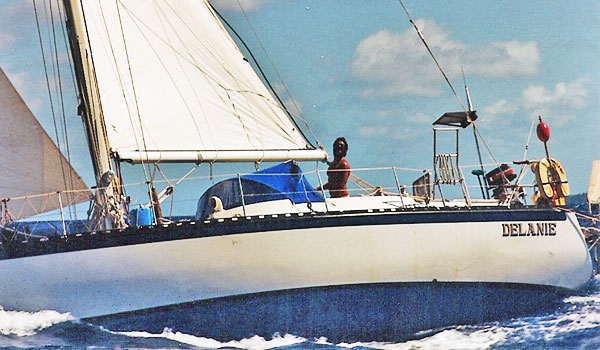 |
| The
Suberis' 43-foot racing sloop, Delanie |
The Suberis hadn't planned to sail around the
world, at least not at first. They spent the first year of their
dream in the Caribbean. Then they ran into a group of sailors
copying charts for an around-the-world trip. They bought a set and
tagged along – and eventually they circumnavigated the globe.
An April 21, 1993 St. Louis Post-Dispatch
article on the couple's adventure states that "Barbara Suberi joined
her husband several times, often for several weeks at a stretch."
It wasn’t just Bob on
that boat, I was on that boat too. Since we did have a building
back in St. Louis. He would stay on the boat – he took it across
the Pacific by himself – and I went back to St. Louis to make
sure everything was copasetic.
He was the captain of the boat and he
knew a lot about it – where it was going and stuff like that. I
was more – not so much the passenger, but the first mate.
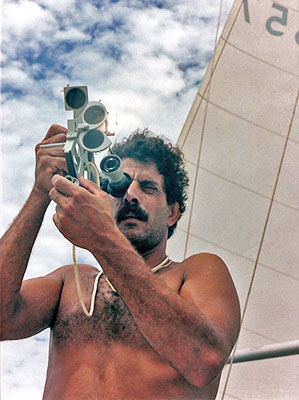 |
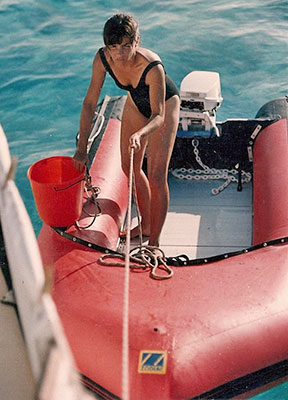 |
| Bob
Suberi |
Barbara
Suberi |
By 1992, the Suberis had returned to a more
mundane life in St. Louis; Bob worked rehabbing houses and Barbara worked as a realtor. But by June
of 1996, they were planning a new restaurant.
We found that
building. It was such an incredible building. It was
ten-thousand square feet, free span. It just needed to have the
ceilings dropped. It took us like six, seven months to do it. It
was really an amazing feat – it was a lot of work. And then we
slowly expanded into the space. It was a great building.
The Suberis "found" and purchased a building in
the heart of Maplewood, at the corner of Manchester and Sutton. It
had originally housed a Katz Drug Store from 1946 until 1972.
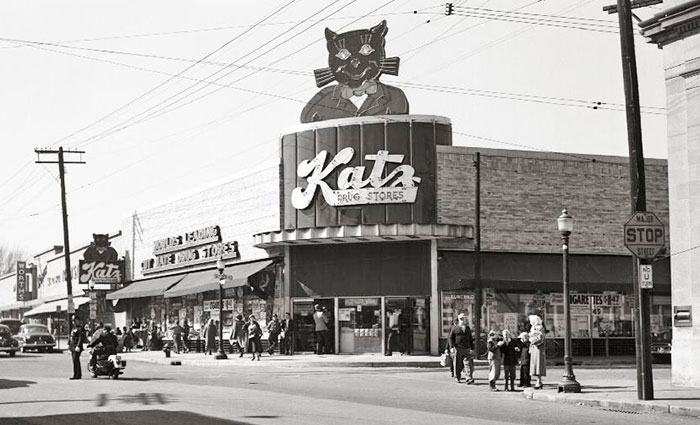 |
| Katz
Drug Store, 7401 Manchester at Sutton, 1958 |
Their new restaurant, which they called simply Bobby's, opened on February
28, 1997. The truncated name was in deference to a menu expanded
beyond the traditional Creole dishes offered at their University
City restaurant.
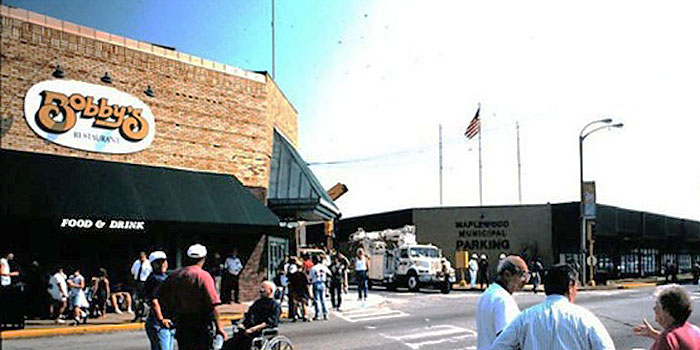 |
|
Bobby's, 7401 Manchester,
1997 |
The restaurant's interior was an imaginative
recreation of a New Orleans street scene and outdoor cafe. The
impression of separate buildings was given by the use of stucco,
brick and siding, punctuated by doors, windows and wrought-iron
balconies with cascading flowers. In 1999, an all-season, indoor
patio was added on the Sutton side of the building.
 |
| Bobby's
Dining Room, 7401 Manchester |
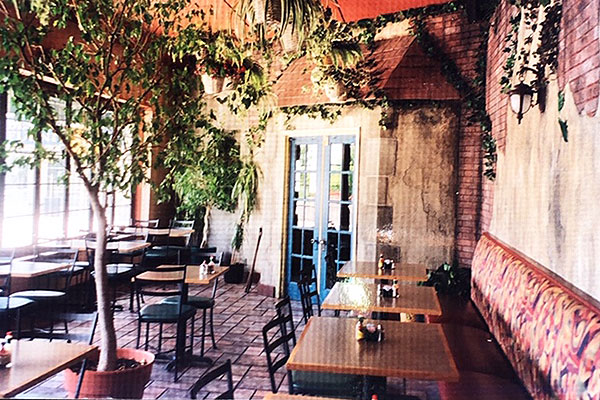 |
| Bobby's
Patio, 7401 Manchester |
We had a great time
with it. All kinds of
different people we found to work on it. And then as we got into
it, we realized that we had to run the thing.
My real estate business was doing
very well. I was just going to come in and for like a month just
show somebody how to run the kitchen. That didn’t happen. I had to drop
the real estate thing and I was there full time. Bob would have
been there running it. As it worked out, I had to be in the
kitchen full time. He was front of the house and I was back of the house,
and that’s the way it had to be.
Bobby's menu featured a variety of New
Orleans-style dishes, but also offered an array of other
entrees, including tropical island fare such as Gado Gado, a
spicy, vegetarian street-food salad with ground peanuts, vegetables
and fish sauce, and Polasami, a mildly spiced, sweet
Melanesian stew-like dish with coconut. Both were inspired by dishes
sampled on the Suberis' round-the-world sailboat trip.
Big sellers included gumbo, jambalaya, baked oysters, crab cakes,
fried catfish, po'boy sandwiches, barbecued shrimp, stuffed chicken,
stuffed pork and a pecan-encrusted fish of the day.
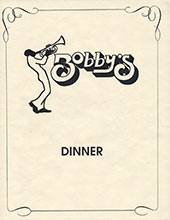 |
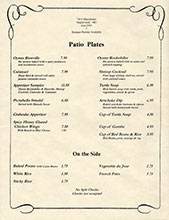 |
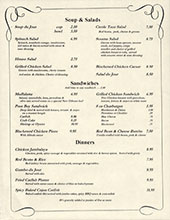 |
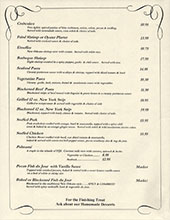 |
Bobby's Creole Menu, circa
2000
(click image to enlarge) |
While the prospect of creating a unique
environment in an "incredible" building had motivated the Suberis to
reopen their restaurant, reality eventually set in.
As you move on you
forget. It’s like when somebody passes away, you only remember
the good things. Well it’s the same thing with the restaurant.
"Remember how good it was? Remember the fun times we had and the
great employees?" That’s what was remembered and this building
comes in and we had this idea of putting a street scene in there
because we could. We could build this incredible thing. It was
like doing an artistic installation and we forgot you also had
to run a restaurant.
By 2003, Bob and Barbara Suberi had had enough
of the restaurant business.
I had had it. He had
had it. The workforce had drastically changed . . . and their
attitude. We’d come into the restaurant and I never knew what
hat I was wearing. Bob was the same. I could be cooking in the
back and also bussing tables at the same time because the busser
hadn’t shown up or the cook hadn’t shown up. But they’d be there
for their paycheck. We looked at each other and said, "I’ve had
it. Have you had it?" So we put our feelers out again and the
Monarch boys appeared.
The Suberis closed Bobby's in March of 2003
and leased their building to Aaron Teitelbaum, who turned it into
Monarch.
We owned the
building, so we had two buildings – we had the one on Delmar and
we had the one on Manchester – and we had two people who would
be paying rent, and we thought, "We’re golden. Let’s get out of
there." So we started looking for a place on the water. That’s
how we ended up in Alabama.
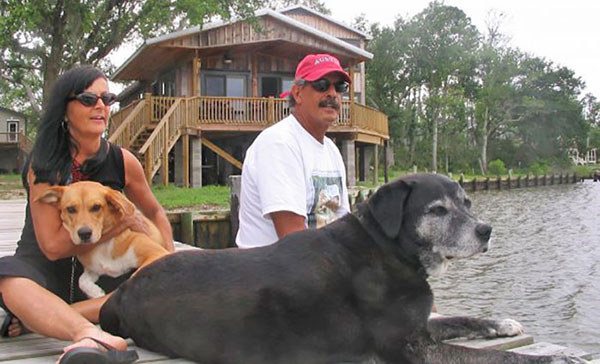 |
|
Barbara and Bob Suberi,
Alabama, 2009 |
The Suberis spent twelve years in Alabama. They bought a
blueberry farm in Loxley, which they dubbed Suberi's Blueberries.
They bought a sailboat and explored the Caribbean. But, eventually, they returned to St. Louis.
I’m a city girl. I
ran out of things to do. I had volunteered for everything. I’m a
painter and I was tired of painting crabs and shrimp and fish
and beach scenes. I just ran out of things to do and so did Bob,
pretty much.
The Suberis' original "Bobby's Creole" sign had
hung on their Alabama guest house; it's now in their Affton
basement. And they still own the 6307-09 Delmar building in the
University City Loop. Perhaps one day they'll again "remember how
good it was."
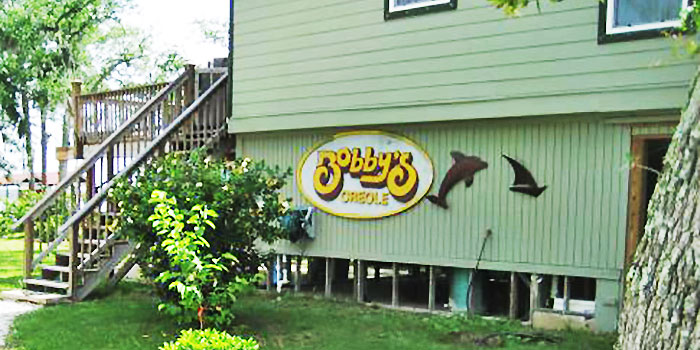 |
|
Suberi Alabama Guest
House, 2009 |
Copyright © 2020
LostTables.com
Lost TablesTM
is a trademark of LostTables.com. All rights reserved. |































